The Sandy Bridge Review: Intel Core i7-2600K, i5-2500K and Core i3-2100 Tested
by Anand Lal Shimpi on January 3, 2011 12:01 AM ESTGaming Performance
There's simply no better gaming CPU on the market today than Sandy Bridge. The Core i5 2500K and 2600K top the charts regardless of game. If you're building a new gaming box, you'll want a SNB in it.
Our Fallout 3 test is a quick FRAPS runthrough near the beginning of the game. We're running with a GeForce GTX 280 at 1680 x 1050 and medium quality defaults. There's no AA/AF enabled.
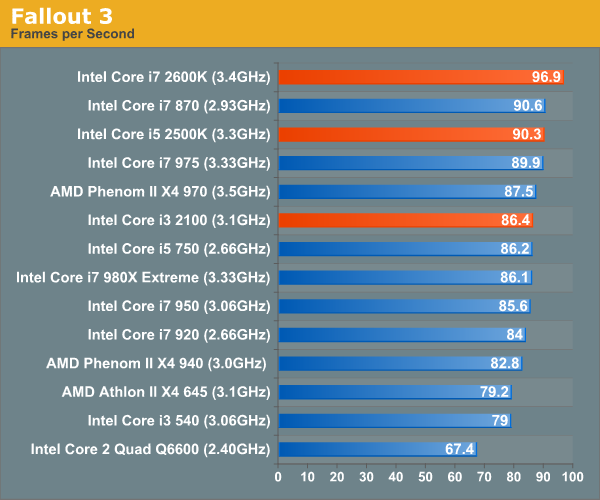
In testing Left 4 Dead we use a custom recorded timedemo. We run on a GeForce GTX 280 at 1680 x 1050 with all quality options set to high. No AA/AF enabled.

Far Cry 2 ships with several built in benchmarks. For this test we use the Playback (Action) demo at 1680 x 1050 in DX9 mode on a GTX 280. The game is set to medium defaults with performance options set to high.
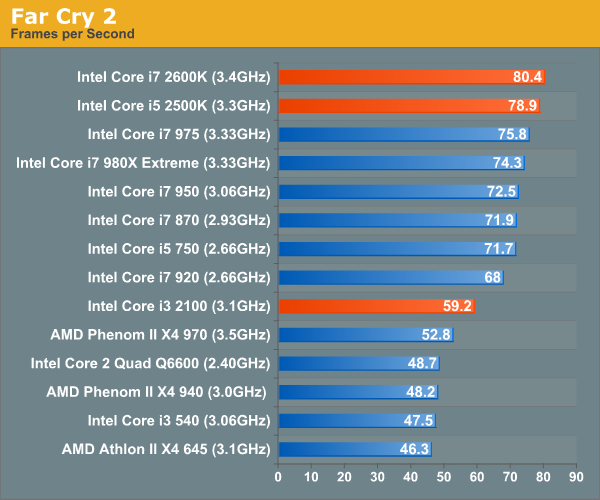
Crysis Warhead also ships with a number of built in benchmarks. Running on a GTX 280 at 1680 x 1050 we run the ambush timedemo with mainstream quality settings. Physics is set to enthusiast however to further stress the CPU.
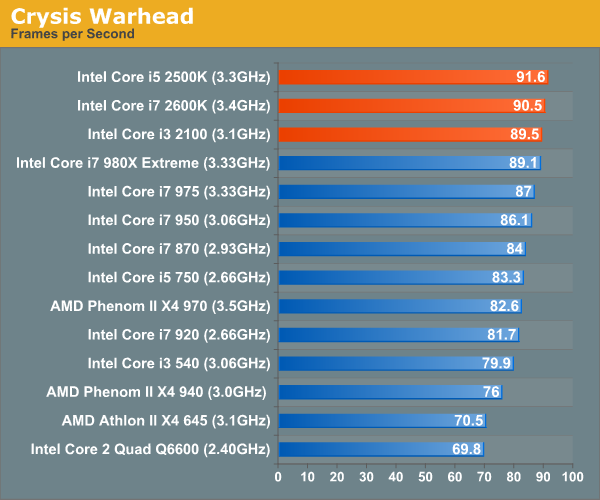
Our Dragon Age: Origins benchmark begins with a shift to the Radeon HD 5870. From this point on these games are run under our Bench refresh testbed under Windows 7 x64. Our benchmark here is the same thing we ran in our integrated graphics tests - a quick FRAPS walkthrough inside a castle. The game is run at 1680 x 1050 at high quality and texture options.
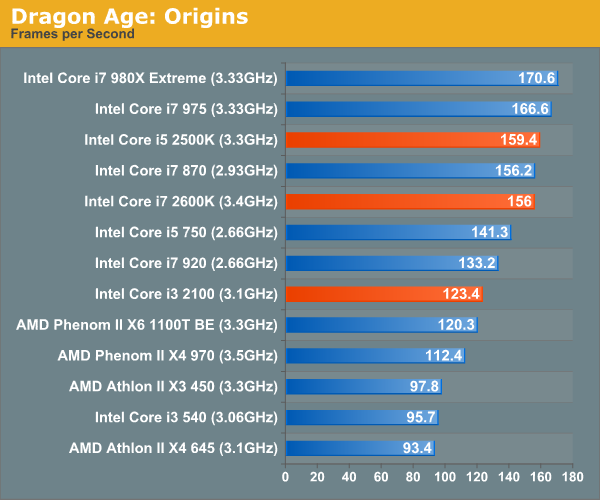
We're running Dawn of War II's internal benchmark at high quality defaults. Our GPU of choice is a Radeon HD 5870 running at 1680 x 1050.
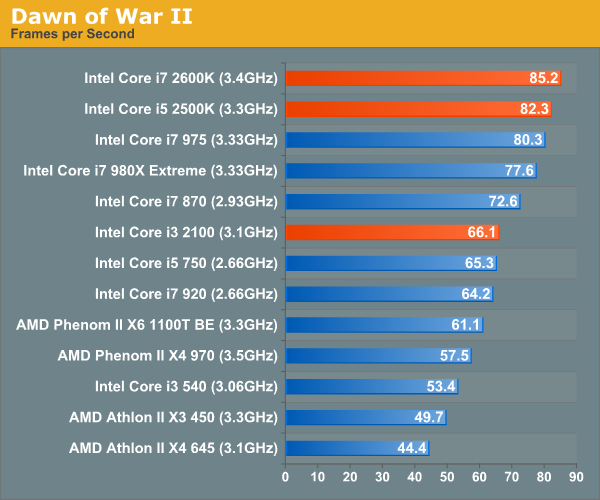
Our World of Warcraft benchmark is a manual FRAPS runthrough of a lightly populated server with no other player controlled characters around. The frame rates here are higher than you'd see in a real world scenario, but the relative comparison between CPUs is accurate.
We run on a Radeon HD 5870 at 1680 x 1050. We're using WoW's high quality defaults but with weather intensity turned down all the way.
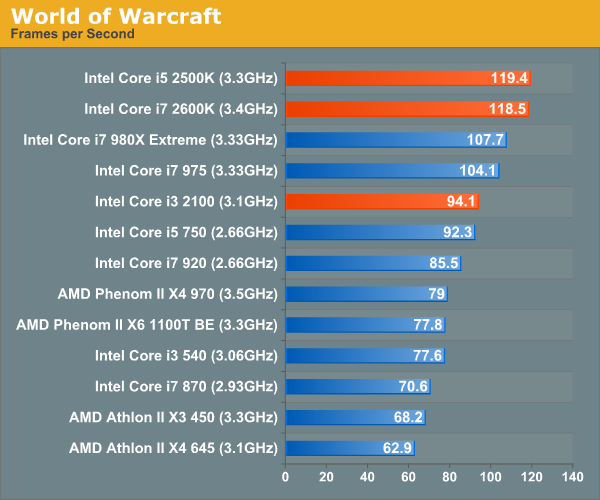
For Starcraft II we're using our heavy CPU test. This is a playback of a 3v3 match where all players gather in the middle of the map for one large, unit-heavy battle. While GPU plays a role here, we're mostly CPU bound. The Radeon HD 5870 is running at 1024 x 768 at medium quality settings to make this an even more pure CPU benchmark.
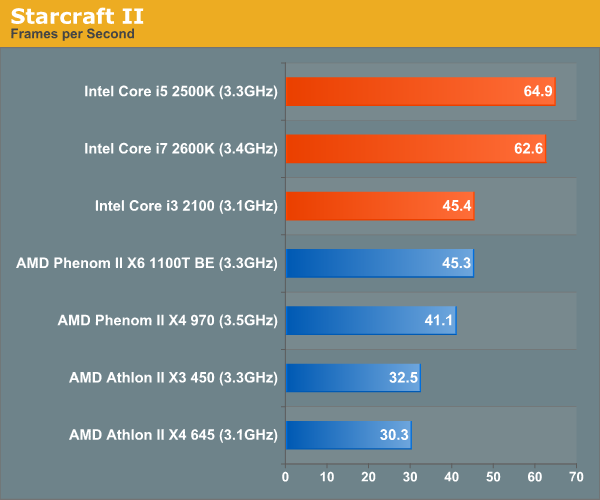
This is Civ V's built in Late GameView benchmark, the newest addition to our gaming test suite. The benchmark outputs three scores: a full render score, a no-shadow render score and a no-render score. We present the first and the last, acting as a GPU and CPU benchmark respectively.
We're running at 1680 x 1050 with all quality settings set to high. For this test we're using a brand new testbed with 8GB of memory and a GeForce GTX 580.
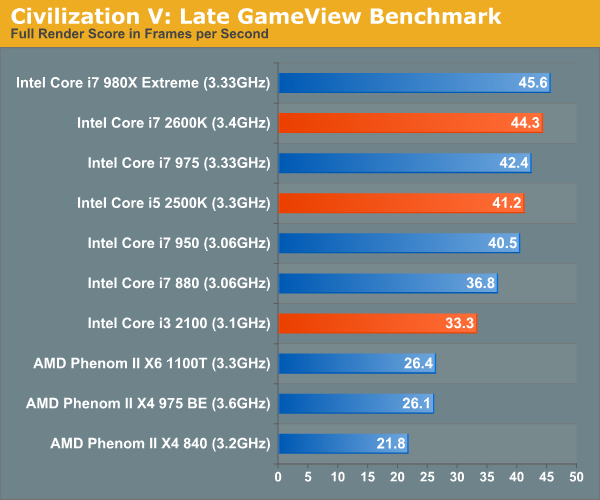
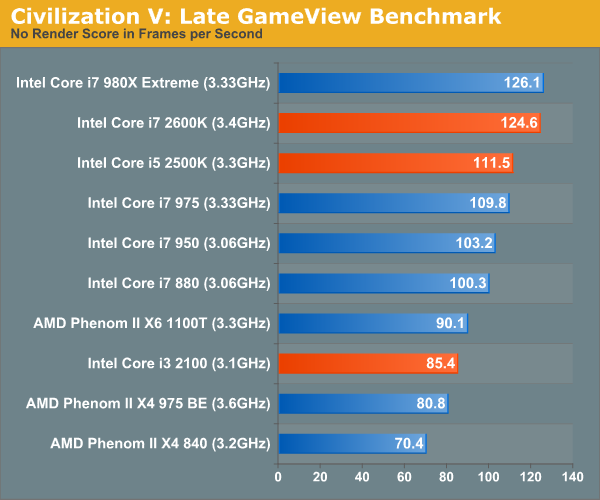










283 Comments
View All Comments
nuudles - Monday, January 3, 2011 - link
Anand, im not the biggest intel fan (due to their past grey area dealings) but I dont think the naming is that confusing. As I understand it they will move to the 3x00 series with Ivy Bridge, basically the higher the second number the faster the chip.It would be nice if there was something in the name to easily tell consumers the number of cores and threads, but the majority of consumers just want the fatest chip for their money and dont care how many cores or threads it has.
The ix part tells enthusiasts the number of cores/threads/turbo with the i3 having 2/4/no, the i5 having 4/4/yes and i7 4/8/yes. I find this much simpler than the 2010 chips which had some dual and some quad core i5 chips for example.
I think AMD's gpus has a sensible naming convention (except for the 68/6900 renaming) without the additional i3/i5/i7 modifier by using the second number as the tier indicator while maintaining the rule of thumb of "a higher number within a- generation means faster", if intel adopted something similar it would have been better.
That said I wish they stick with a naming convention for at least 3 or 4 generations...
nimsaw - Monday, January 3, 2011 - link
",,but until then you either have to use the integrated GPU alone or run a multimonitor setup with one monitor connected to Intel’s GPU in order to use Quick Sync"So have you tested the Transcoding with QS by using an H67 chipset based motherboard? The Test Rig never mentions any H67 motherboard. I am somehow not able to follow how you got the scores for the Transcode test. How do you select the codepath if switching graphics on a desktop motherboard is not possible? Please throw some light on it as i am a bit confused here. You say that QS gives a better quality output than GTX 460, so does that mean, i need not invest in a discrete GPU if i am not gaming. Moreover, why should i be forced to use the discrete GPU in a P67 board when according to your tests, the Intel QS is giving a better output.
Anand Lal Shimpi - Monday, January 3, 2011 - link
I need to update the test table. All of the Quick Sync tests were run on Intel's H67 motherboard. Presently if you want to use Quick Sync you'll need to have an H67 motherboard. Hopefully Z68 + switchable graphics will fix this in Q2.Take care,
Anand
7Enigma - Monday, January 3, 2011 - link
I think this needs to be a front page comment because it is a serious deficiency that all of your reviews fail to properly describe. I read them all and it wasn't until the comments came out that this was brought to light. Seriously SNB is a fantastic chip but this CPU/mobo issue is not insignificant for a lot of people.Wurmer - Monday, January 3, 2011 - link
I haven't read through all the comments and sorry if it's been said but I find it weird that the most ''enthusiast'' chip K, comes with the better IGP when most people buying this chip will for the most part end up buying a discreet GPU.Akv - Monday, January 3, 2011 - link
It's being said in reviews from China to France to Brazil, etc.nimsaw - Monday, January 3, 2011 - link
Strangely enough i also have the same query. what is the point of better Integrated graphics when you cannot use them on a P67 mobo?also i came across this screen shot
http://news.softpedia.com/newsImage/Intel-Sandy-Br...
where on the right hand corner you have a Drop Down menu which has selected Intel Quick Sync. Will you see a discrete GPU if you expand it? Does it not mean switching between graphics solutions. In the review its mentioned that switchable graphics is still to find its way in desktop mobos.
sticks435 - Tuesday, January 4, 2011 - link
It looks like that drop down is dithered, which means it's only displaying the QS system at the moment, but has a possibility to select multiple options in the future or maybe if you had 2 graphics cards etc.HangFire - Monday, January 3, 2011 - link
You are comparing video and not chipsets, right?I also take issue with the statement that the 890GX (really HD 4290) is the current onboard video cream of the crop. Test after test (on other sites) show it to be a bit slower than the HD4250, even though it has higher specs.
I also think Intel is going to have a problem with folks comparing their onboard HD3000 to AMD's HD 4290, it just sounds older and slower.
No word on Linux video drivers for the new HD2000 and HD3000? Considering what a mess KMS has made of the old i810 drivers, we may be entering an era where accelerated onboard Intel video is no longer supported on Linux.
mino - Wednesday, January 5, 2011 - link
Actually, 890GX is just a re-badged 780G from 2008 with sideport memory.And no HD4250 is NOT faster. While some specific implementation of 890GX wthout sideport _might_ be slower, it would also be cheaper and not really a "proper" representative.
(890GX withou sedeport is like sayin i3 with dual channel RAM is "faster" in games than i5 with single channel RAM ...)